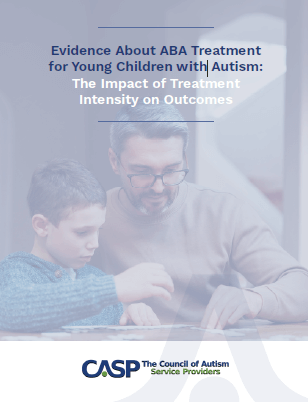Evidence About ABA Treatment
for Young Children with Autism:
The Impact of Treatment
Intensity on Outcomes
for Young Children with Autism:
The Impact of Treatment
Intensity on Outcomes
This is one of the best pieces of work I have read in a long time! It's insightful, very well-written, and impactful. Well done, CASP!
Dr. Doreen Granpeesheh, Center for Autism and Related Disorders (CARD)
Overview
This paper—a companion to Applied Behavior Analysis (ABA) Practice Guidelines for the Treatment of Autism Spectrum Disorder—summarizes evidence about early, comprehensive, intensive ABA treatment as well as generally accepted standards of care for young children receiving ABA. It also overviews the processes relevant to developing and updating standards.
Evidence About ABA Treatment for Young Children with Autism also addresses a recent meta-analysis of treatment outcomes by Dr. Sigmund Eldevik and his colleagues. The paper highlights the critical role of treatment intensity on outcomes. And it provides benchmarks to use in evaluating the outcomes of ABA treatment delivered to young autistic children. These same benchmarks can be applied to evaluate the effectiveness of other treatment approaches delivered to this pediatric population.
Further, the paper evaluates recent studies in which the authors claim that both high and low treatment intensities produce similar outcomes. It contextualizes those claims by identifying concerns about the methodology, design, and understanding of early intensive intervention for young children with autism in these studies.
Finally, it provides resources to help parents and caregivers understand the variables that influence children’s outcomes in early, comprehensive, intensive ABA.
Click here to read the paper.
Table of Contents
- Executive Summary.
- Introduction.
- Generally Accepted Standards of Care.
- Evidence-Based Practice.
- Evaluating the Evidence.
- Generally Accepted Standards of Care for Young Children.
- Relationship Between Scope and Intensity in Treatment.
- Evidence Base About Early Comprehensive Intensive ABA Treatment for Young Children with Autism.
- Critiques of Recent Studies.
- Summary.
- References.
Appendices
- Appendix A. Sample daily schedule for early comprehensive intensive ABA treatment.
- Appendix B. Infographic for parents and caregivers about ABA treatment for young children.
- Appendix C. Guidelines and references to share with parents and caregivers about ABA treatment for young children.
- Appendix D. Potential Topics for Clinicians to Discuss with Parents and Caregivers Regarding ABA Treatment for Young Children.
References
- American Medical Association (2023). Definitions of “Screening” and “Medical Necessity”
H-320.953. https://policysearch.ama-assn.org/policyfinder/detail/medical%20necessity?uri=%2FAMADoc%2FHOD.xml-0-2625.xml - American Diabetes Association. (2023). Standards of care in diabetes - 2023 abridged for
primary care providers. Clinical Diabetes, 41(1), 4–31. https://doi.org/10.2337/cd23-as01 - American Psychological Association (2019). APA clinical practice guideline for the treatment
of depression across three age cohorts. Washington, DC: Author https://www.apa.org/depression-guideline/guideline.pdf - Bayley, N. (2019). Bayley Scales of Infant and Toddler Development (4th ed.). Pearson.
Behavior Analysts Certification Board. 2020. Ethics code for behavior analysts. https://www.bacb.com/wp-content/uploads/2022/01/Ethics-Code-for-Behavior-Analysts-240830-a.pdf - Ben-Itzchak, E., & Zachor, D. A. (2007). The effects of intellectual functioning and autism
severity on outcome of early behavioral intervention for children with autism. Research in
developmental disabilities, 28(3), 287-303. - Birnbrauer, J. S., & Leach, D. J. (1993). The Murdoch early intervention program after 2 years.
Behaviour Change, 10(2), 63-74. - Boness, C. L., Hershenberg, R., Grasson, D., Kaye, J., Mackintosh, M. A., Nason, E., Shah, A.
& Raffa, S. D. (2021). The Society of Clinical Psychology’s Manual for the Evaluation of
Psychological Treatments Using the Tolin Criteria. https://osf.io/preprints/osf/8hcsz_v1 - Council of Autism Service Providers. (2024). Applied behavior analysis practice guidelines for
the treatment of Autism Spectrum Disorder: Guidance for healthcare funders, regulatory
bodies, service providers, and consumers (Third 3rd ed.). Author. - Cohen, H., Amerine-Dickens, M., & Smith, T. (2006). Early intensive behavioral treatment:
Replication of the UCLA model in a community setting. Journal of Developmental &
Behavioral Pediatrics, 27(2), S145–S155. https://doi.org/10.1097/00004703-200604002-00013 - Cooke, B. K., Worsham, E., & Reisfield, G. M. (2017). The elusive standard of care. Journal of
the American Academy of Psychiatry Law, 45(3), 358-364. - Custer, T. N., Stiehl, C. M., & Lerman, D. C. (2021). Outcomes of a practical approach for
improving conversation skills in adults with autism. Journal of Applied Behavior Analysis,
54(1), 309-333. - Dawson, G. (2008). Early behavioral intervention, brain plasticity, and the prevention of
autism spectrum disorder. Development and Psychopathology, 20(3), 775-803. - Eikeseth, S., Smith, T, Jahr, E., & Eldevik, S. (2007). Outcome for children with autism who
30 Evidence About ABA Treatment for Young Children Diagnosed with Autism
began intensive behavioral treatment between ages 4 and 7: A comparison controlled
study. Behavior Modification, 31, 264-278. https://doi.org/10.1177/0145445506291396 - Eldevik, S., Eikeseth, S., Jahr, E., & Smith, T. (2006). Effects of low-intensity behavioral
treatment for children with autism and mental retardation. Journal of Autism and
Developmental Disorders, 36, 211-224. https://doi.org/10.1007/s10803-005-0058-x - Eldevik, S., Hastings, R.P., Hughes, J.C., Jahr, E., Eikeseth, S., & Cross, S. (2009). Meta-analysis
of early intensive behavioral intervention for children with autism. Journal of Clinical
Child & Adolescent Psychology, 38, 439–450. https://doi.org/10.1080/15374410902851739 - Eldevik, S., Hastings, R. P., Hughes, J. C., Jahr, E., Eikeseth, S., & Cross, S. (2010). Using
participant data to extend the evidence base for intensive behavioral intervention for
children with autism. American Journal on Intellectual and Developmental Disabilities,
115,(5), 381-–405. https://doi.org/10.1352/1944-7558-115.5.381 - Eldevik, S., Titlestad, K. B., Aarlie, H., & Tønnesen, R. (2020). Community implementation of
early behavioral intervention: Higher intensity gives better outcome. European Journal of
Behavior Analysis, 21(1), 92-109. - Eldevik, S., Strømgren, B., Eikeseth, S., Field, A., Goetz, C. M., & Titlestad, K. B. (2024).
Clinically significant outcomes of early intensive behavioral intervention for children with
Autism Spectrum Disorders; An Individual Participant Data Meta-analysis. Submitted. - Federal Register (2024, September 23). Requirements related to the Mental Health Parity and
Addiction Equity Act. Washington, DC: National Archives. - Fisher, W. W., Piazza, C. C., & Fuhrman, A. M. (2021). Developing a severe behavior program:
A toolkit. Autism Speaks Thought Leadership Summit on Challenging Behaviors. Autism
Speaks. https://docs.autismspeaks.org/behavior-program/ - Frazier, T. W., Chetcuti, L., & Uljarevic, M. (2024). Evidence that intervention dosage is
associated with better outcomes in autism. Journal of the American Medical Association-
Pediatrics, 179(1), 101-102. https://doi:10.1001/jamapediatrics.2024.4710 - Gomes, C. G. S., Souza, D. D. G. D., Silveira, A. D., Rates, A. C., Paiva, G. C. D. C., & Castro,
N. P. D. (2019). Efeitos de intervenção comportamental intensiva realizada por meio da
capacitação de cuidadores de crianças com autismo. Psicologia: Teoria e Pesquisa, 35,
e3523. - Green, G., Brennan, L. C., & Fein, D. (2002). Intensive behavioral treatment for a toddler at
high risk for autism. Behavior Modification, 26(1), 69–102. https://doi.org/10.1177/0145445502026001005 - Haraguchi, H., Yamaguchi, H., Miyake, A., Tachibana, Y., Stickley, A., Horiguchi, M., Inoue, M.,
Noro, F., & Kamio, Y. (2020). One-year outcomes of low-intensity behavioral interventions
among Japanese preschoolers with autism spectrum disorders: Community-based
study. Research in Autism Spectrum Disorders, 76, 101556. https://doi.org/10.1016/j.rasd.2020.101556 - Howard, J. S., Stanislaw, H. G., Green, G., Sparkman, C. R., & Cohen, H. G. (2014). Comparison
of behavior analytic and eclectic early interventions for young children with autism after three years. Research in Developmental Disabilities, 35, 3326-3344. http://dx.doi.org/10.1016/j.ridd.2014.08.021 - Hume, K., Steinbrenner, J. R., Odom, S. L., Morin, K. L., Nowell, S. W., Tomaszewski, B., ... &
Savage, M. N. (2021). Evidence-based practices for children, youth, and young adults with
autism: Third generation review. Journal of autism and developmental disorders, 1-20. - Jacobson, N. S., & Truax, P. (1991). Clinical significance: A statistical approach to defining
meaningful change in psychotherapy research. Journal of Consulting and Clinical
Psychology, 59(1), 12–19. https://doi.org/10.1037/0022-006X.59.1.12 - Johnston, J. M., Pennypacker, H. S., & Green, G. (2019). Strategies and tactics of behavioral
research and practice (4th ed). New York: Routledge.
Kass, N. E., Faden, R. R., Angus, D. C., & Morain, S. R. (2025). Making the ethical oversight of
all clinical trials fit for purpose. JAMA, 333(1), 75-80. - Kinney, E. D. (2004). The origins and promise of medical standards of care. Virtual Mentor,
6(12), 574-576. doi:10.1001/virtualmentor.2004.6.12.mhst1-0412. - Klintwall, L., Eldevik, S., & Eikeseth, S. (2015). Narrowing the gap: Effects of intervention on
developmental trajectories in autism. Autism, 19(1), 53-63. - Linstead, E., Dixon, D. R., Hong, E., Burns, C. O., Novack, M. N., & Granpeeshah, D. (2017).
An evaluation of the effects of intensity and duration on outcomes across treatment
domains for children with autism spectrum disorder. Translational Psychiatry, 7, e1234.
https://doi.org/10.1038/tp.2017.207 - Lotfizadeh, A. D., Kazemi, E., Pompa-Craven, P., & Eldevik, S. (2020). Moderate effects of low intensity
behavioral intervention. Behavior modification, 44(1), 92-113. - Lovaas, O. I. (1987). Behavioral treatment and normal educational and intellectual functioning
in young autistic children. Journal of Consulting and Clinical Psychology, 55 (1): 3–9.
doi:10.1037/0022-006x.55.1.3. ISSN 1939-2117. PMID 3571656. - McEachin, J. J., Smith, T., & Lovaas, O. I. (2013). Long-Term Outcome for Children With Autism
Who Received Early Intensive Behavioral Treatment. In Autism (pp. 253-266). Routledge. - National Autism Center. (2015). National Standards Project Findings and Conclusions: Phase 2.
Author. - Neil, N., Amicarelli, A., Anderson, B. M., & Liesemer, K. (2021). A meta-analysis of single-case
research on applied behavior analytic interventions for people with down syndrome. American Journal on Intellectual and Developmental Disabilities, 126(2), 114-141. - O’Connor, A. B., & Healy, O. (2010). Long-term post-intensive behavioral intervention
outcomes for five children with autism spectrum disorder. Research in Autism Spectrum
Disorders, 4, 594-604. doi:10.1016/j.rasd.2009.12.002 - Orin, A. J., Helt, M., Troyb, E., Tyson, K. E., Barton, M. L., Eigsti, I. M., ... & Fein, D. A. (2014).
Intervention for optimal outcome in children and adolescents with a history of autism.
Journal of Developmental & Behavioral Pediatrics, 35(4), 247-256. - Ostrovsky, A., Willa, M., Cho, T., Strandberg, M., Howard, S., & Davitian, C. (2023). Data-driven,
client-centric applied behavior analysis treatment-dose optimization improves functional
outcomes. World Journal of Pediatrics, 19(8), 753–760. https://doi.org/10.1007/s12519-022-00643-0 - Ramey, C.T. and Ramey, S.L. Early intervention and early experience. American Psychologist, Vol 53(2) 109-120.
- Padilla, K.L., Weston, R., Morgan, G.B., Lively, P., & O’Guinn, N. (2023). Validity and reliability
evidence for assessments based in applied behavior analysis: A systematic review.
Behavior Modification, 47(1), 247-288. - Page, M. J., Moher, D., Bossuyt, P. M., Boutron, I., Hoffmann, T. C., Mulrow, C. D., ... &
McKenzie, J. E. (2021). PRISMA 2020 explanation and elaboration: updated guidance and
exemplars for reporting systematic reviews. bmj, 372. - Perry, A., Koudys, J., Prichard, A., & Ho, H. (2019). Follow-up study of youth who received EIBI
as young children. Behavior Modification, 44(2), 181-201. https://doi.org/10.1177/0145445517746916 - Peters-Scheffer, N., Didden, R., Mulders, M., & Korzilius, H. (2010). Low intensity behavioral
treatment supplementing preschool services for young children with autism spectrum
disorders and severe to mild intellectual disability. Research in Developmental Disabilities,
31, 1678-1684. doi.org/10.1016/j.ridd.2010.04.008 - Ridout, S., & Eldevik, S. (2024). Measures used to assess treatment outcomes in children
with autism receiving early and intensive behavioral interventions: A review. Review
Journal of Autism and Developmental Disorders, 11, 607–619. https://doi.org/10.1007/s40489-023-00355-9 - Roid, G.H. (2003). Stanford-Binet Intelligence Scales. 5. Riverside Publishing.
- Sandbank, M., Bottema-Beutel, K., Crowley, S., Cassidy, M., Dunham, K., Feldman, J. I., ... &
Woynaroski, T. G. (2020). Project AIM: Autism intervention meta-analysis for studies of
young children. Psychological bulletin, 146(1), 1. - Sandbank, M., Pustejovsky, J. E., Bottema-Beutel, K., Caldwell, N., Feldman, J. I., Crowley
LaPoint, S., & Woynaroski, T. (2024). Determining associations between intervention
amount and outcomes for young autistic children: A meta-analysis. Journal of the
American Medical Association - Pediatrics, 178(8), 763–773. https://doi.org/10.1001/jamapediatrics.2024.1832 - Schopler, E., Van Bourgondien, M. E., Wellman, G. J., & Love, S. R. (2010). The Childhood
Autism Rating Scale (2nd ed.) (CARS2). - Slocum, T. A., Detrich, R., Wilczynski, S. M., Spencer, T. D., Lewis, T., & Wolfe, K. (2014). The
evidence-based practice of applied behavior analysis. The Behavior Analyst, 37(1), 41–56.
https://doi.org/10.1007/s40614-014-0005-2 - Smith, D. P., Hayward, D. W., Gale, C. M., Eikeseth, S., & Klintwall, L. (2021). Treatment gains
from early and intensive behavioral intervention (EIBI) are maintained 10 years later.
Behavior modification, 45(4), 581–601. https://doi.org/10.1177/0145445519882895 - Sparrow, S. S., Cicchetti, D. V., & Saulnier, C. A. (2016). Vineland Adaptive Behavior Scales,
(Vineland-3). Pearson Assessments. - Stanislaw, H., Howard, J., & Martin, C. (2020). Helping parents choose treatments for young
children with autism: A comparison of applied behavior analysis and eclectic treatments.
Journal of the American Association of Nurse Practitioners, 32(8), 571-578. https://doi.org/10.1097/
JXX.0000000000000290 - Steinbrenner, J. R., Hume, K., Odom, S. L., Morin, K. L., Nowell, S. W., Tomaszewski, B., ... &
Savage, M. N. (2020). Evidence-based practices for children, youth, and young adults with
autism. FPG child development institute. - Titlestad, K. B., & Eldevik, S. (2019). Brief Report: Modest but Clinically Meaningful Effects
of Early Behavioral Intervention in Twins with Rett Syndrome-A Case Study. Journal of
Autism and Developmental Disorders, 49(12), 5063–5072. https://doi.org/10.1007/s10803-
019-04185-9 - Tolin, D. F., McKay, D., Forman, E. M., Klonsky, E. D., & Thombs, B. D. (2015). Empirically
supported treatment: Recommendations for a new model. Clinical Psychology: Science
and Practice, 22(4), 317–338. https://doi.org/10.1037/h0101729 - Virués-Ortega, J. (2010). Applied behavior analytic intervention for autism in early childhood.
Clinical Psychology Review, 30, 387-399. https://doi.org/10.1016/j.cpr.2010.01.008 - Virués-Ortega, J., Rodríguez, V., & Yu, C. T. (2013). Prediction of treatment outcomes and
longitudinal analysis in children with autism undergoing intensive behavioral intervention.
International Journal of Clinical and Health Psychology, 13, 91-100. https://doi.org/10.1016/S1697-
2600(13)70012-7 - Waters, C.F., Dickens, M.A., Thurston, S.W., Lu, X., & Smith, T. (2020). Sustainability of
early intensive behavioral intervention for children with autism spectrum disorder in a
community setting. Behavior Modification, 44(1), 3-2 - Wechsler, D. (2014). Wechsler intelligence scale for children (5th ed.). PsychCorp.
- What Works Clearinghouse. (2022). What Works What house Procedures and Standards
Handbook, Version 5.0. Washington, DC: U.S. Department of Education, Institute of
Education Sciences, National Center for Education Evaluation and Regional Assistance.
https://files.eric.ed.gov/fulltext/ED621928.pdf - Wilkinson, E., Farmer, C., Kleiman, E., & Bal, V. H. (2024). Factor structure of the VABS-3
Comprehensive Parent/Caregiver form in autistic individuals: Poor fit of three-factor and
unidimensional models. Autism, 28(3), 616-626. - Wolf, M.M., Risley, T.R., Johnston, M.K., Harris, F.R., & Allen, K.E. (1967). Application of operant
conditioning procedures to the behaviour problems of an autistic child: A follow up and
extension. Behaviour Research and Therapy, 5, 103-111. - Wolf, M.M., Risley, T.R., & Mees, H. (1964). Application of operant conditioning procedures to
the behaviour problems of an autistic child. Behaviour Research and Therapy, 1, 305-312. - Wójcik, M., Eikeseth, S., Eikeseth, F. F., Budzinska, E., & Budzinska, A. (2023). A comparison
controlled study examining outcome for children with autism receiving intensive
behavioral intervention (IBI). Behavior Modification, 47(5), 1071-1093.



